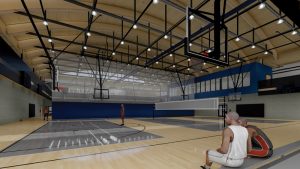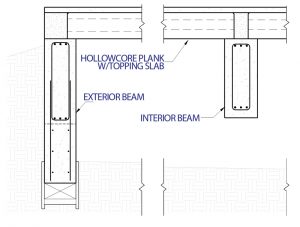The Oscar Johnson Jr. Community Center in Conroe, Texas, will begin construction in 2022. The project’s architecture firm is Burditt Consultants and the structural engineering firm is DUDLEY. The building will utilize mass timber construction and is intended to be an architectural statement for the community. Its 120,000 square feet of public space strives to affect countless lives for more than one hundred years. To fulfill that goal, however, the building needs to stand the test of time. There are many factors and environmental loads at play, but perhaps the most daunting is expansive soils. DUDLEY’s solution is building the Community Center’s foundation using a suspended hollow core plank slab system supported by elevated concrete beams constructed on top of belled piers. The system is designed to decouple as much of the structure as possible from expansive soil movements while saving overall foundation cost and construction time. It also allows for ease of future modification/repair for plumbing and mechanical systems, given that there is direct access to the crawl space.

Expansive Soils
Expansive soils contain near-surface clay and are thus prone to volumetric changes as moisture content fluctuates. Seasonal moisture variations can cause expansive soils to shrink and swell differentially and induce swell pressures over 4,000 pounds per square foot. Engineers conventionally design stiffened slab-on-grade foundations to resist the effects of expansive soil movements.
In regions that contend with highly expansive clay soils, it is common for 2 to 6 feet of existing soil to be removed over the entirety of the building footprint and replaced with compacted select fill soils consisting of low expansive clay soils with low permeability. This cut-and-replace procedure is both costly and time-consuming. The process of compacting the select fill is especially a burden. It must be done in approximately 6-inch lifts and is usually required to be done to 95% of the maximum dry density. Compaction efforts also become increasingly difficult as both the building footprint and the excavation depth grow due to increased complexity in logistics/quality control and increased exposure to rain delays (which frequently causes damage to previously completed work). This work must be completed before constructing any concrete foundation elements, adding months to the overall project construction timeline on large projects. Perhaps adding salt to the wound, removing and replacing expansive soil merely mitigates damage due to foundation movement. There will still always be a risk for structural, functional, or cosmetic distress (the latter being most common).
Site Considerations
The Community Center will inhabit a site consisting of an average plasticity index of 50, a very high value. Therefore, initial geotechnical recommendations were that the top 6 feet of native topsoil should be removed and replaced with soils having a plasticity index of between 10 and 20. This is not an unexpected requirement. The native soils present in the site are not of good quality, and their intense shrink/swell potential would likely cause structural damage if left in place. Therefore, soil removal was necessary and could not be worked around. But what if the soil fill operations that follow could be eliminated? The fill operations are particularly undesirable for this project, with a foundation footprint of about 65,000 square feet. That would equate to a little over 14,400 cubic yards of compacted fill soil that would take additional months (depending on weather conditions) to execute in the field correctly. Realizing this, DUDLEY decided to explore a suspended foundation as an option. This approach comes with many benefits, primarily that it removes the foundation slab from direct contact with soil, decoupling it from expansive soil behavior (piers are still in contact with the soil). Additionally, it also precludes the need to purchase and painstakingly place select fill. In aggregate, this decision should prove to save time, save money, and improve quality, a trifecta rarely achieved.
Design and Construction
Since this building is being built using a suspended foundation, the excavation only needs to be as deep as the overall depth of the slab framing system plus an air gap for maintenance crew maneuverability. Hollow core planks were selected as the slab system for the project because of their speed of installation given the Community Center’s footprint. Hollow core planks are a precast concrete element that, with the combined power of prestressing and cast-in voids, can span long lengths at light weights for concrete construction. The author’s firm selected a maximum hollow core plank span length of 30 feet based on building layout and then determined that the typical hollow core plank depth should be 10 inches with an additional 2 inches of topping slab for a total depth of 12 inches. Correspondingly, concrete beams supporting the slab were limited to a maximum span length of 30 feet, yielding a 3-foot beam depth. Concrete piers that extend 12 feet below the existing grade support these concrete beams. Superstructure columns were also located on top of beam-pier connections. Regarding the aforementioned air gap, the entire design team determined it would need to be 2 feet deep for this project, though this is ultimately a judgment call. Therefore, given the selected slab depth, beam depth, and air gap, the excavation depth for this building will be 6 feet.

There are some nuances to consider when designing this system:
- Slab drops can be accommodated by selecting thinner hollow core planks and modifying the topping slab thickness. Still, the dropped region should be framed out with beams below, and the maximum slab span may need to be reduced. For example, the gymnasium space was constructed over 8-inch planks due to the entire room needing to be dropped 2 inches, but the plank span was reduced to 24 feet.
- Soil must be retained at the building perimeter to preserve the crawlspace under the slab. This was accomplished by deepening the perimeter concrete beams to extend at least 1 foot below the final grade of the crawl space to act as retaining walls. Tops of the exterior concrete piers were also lowered to match the bottom of these beams. A system of soil retainers and cardboard void forms have been provided to preserve the suspended nature of these exterior beams (as is present at all interior beams).
- It may be tempting to vary the interior beam depths throughout the structure for economy. However, since the concrete piers often support multiple beams and the top of the concrete beam must align with the bottom of the hollow core plank, detailing and constructing this condition at the piers would prove difficult. Therefore, this complexity was not worth it for this project, given the number of conditions that could develop.
As for construction, the 6-foot excavation of the building footprint will happen first. In conventional construction for this region, this is where select fill would be brought to the site. However, that step will be skipped entirely for this project. Next, the contractor can begin drilling and casting piers. On top of these piers, the contractor will then form up and pour the concrete beams used to support the hollow core planks. Once the beams have fully cured, options open up for the contractor to install the building’s columns and hollow core planks simultaneously. This phase should be a relatively quick process since each of these tasks only involve the installation of prefabricated elements. Once both tasks are complete, the topping slab is poured, and the foundation is finished.
Applicability to Other Projects
DUDLEY believes that the suspended slab system described was the best foundation system for this project. The company’s research indicates that this and similar systems are incredibly underutilized in regions with expansive soil. The author encourages other design professionals to explore the possibilities of this foundation type.
The viability of these suspended slabs scales with building footprint size due to the interplay of increased select fill costs and economy of scale benefits gained with precast concrete elements. Therefore, we do not recommend this system for buildings with small footprints.
This project used a combination of cast-in-place beams with precast hollow core plank slabs. Given the scale of the project and the good accessibility of precast elements, precast concrete is generally more economical. While precast beams were an option for this project, they were ultimately not used due to an irregular column/pier grid. With numerous concrete beam-to-girder connections required throughout the project, cast-in-place provided a more natural solution. Another benefit of using cast-in-place beams is the added versatility when it comes to beam penetrations.
Considering lead time for precast element fabrication is essential. Time saved in avoiding the use of select fill does not matter if the same amount of time is lost in waiting for precast elements to arrive at the job site. In pre-construction meetings, it may be helpful to remind general contractors to hire a precast manufacturer as soon as possible.■
